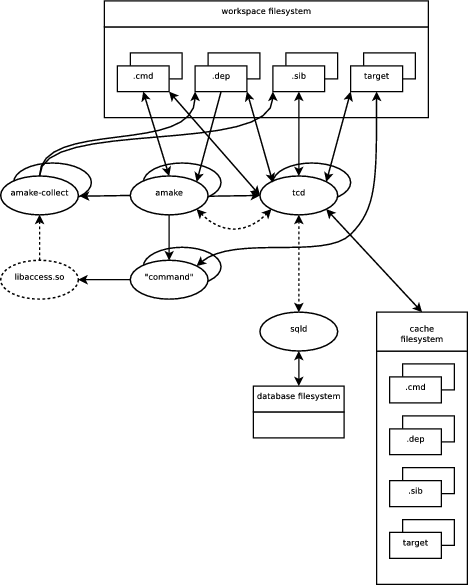
An amake system may encompass multiple amake
processes executing for multiple users on multiple
computers.
If target caching is enabled, multiple tcd processes
may be executing on multiple computers. They are started as
needed, and exit when idle. In contrast, a single long-lived
sqld must be executing.
The components of a executing amake system are shown
in this picture:

Legend:
fork and an
exec.
In the picture, the multiple amake processes indicate
that at least one user has started amake from a
shell. Of course, an amake process can start other
amake processes, via a rule's commands.
In deciding whether a target must be updated, amake
reads the target's .cmd and .dep files,
writing a new .cmd file as needed. These files are
assumed to be in a normal user-private workspace.
If a target must be updated, amake starts an
amake-collect process for the target and executes the
its rule's commands. The commands call wrapper functions in
the libaccess shared-library, which write the
target's dependency data to its amake-collect
process, via an anonymous pipe. amake-collect reads
the target's dependency data from the pipe and writes the
target's .dep and .sib files. As usual, the
commands update the target file in the workspace filesystem.
If the target cache is enabled, the sqld and cache
filesystem are assumed to be available. The cache filesystem
can be shared among workspaces on a single host, or shared
among hosts (via NFS, for example). Files are stored in the
cache filesystem below directories whose names prevent
collisions. The database filesystem holds metadata about
those files (e.g., names and checksums).
If the target cache is enabled, amake consults the
target-cache subsystem, prior to, and perhaps instead of,
executing a rule's commands. If needed, a tcd process
is started. Each amake process has a single
tcd process, with which it communicates via a named
socket. tcd searches the cache for a suitable target,
by querying sqld and analyzing candidates in the
cache filesystem. If successful, files are hard-linked or
copied to the workspace filesystem. If unsuccessful, the
rule's commands are executed as usual, the updated target's
metadata is stored by sqld, and the updated target's
files are hard-linked or copied to the cache filesystem. A
target's siblings are stored in the cache filesystem as a
single tar file.